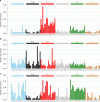Whole-genome sequencing of esophageal adenocarcinoma in Chinese patients reveals distinct mutational signatures and genomic alterations
- PMID: 30374464
- PMCID: PMC6200836
- DOI: 10.1038/s42003-018-0182-8
Whole-genome sequencing of esophageal adenocarcinoma in Chinese patients reveals distinct mutational signatures and genomic alterations
Abstract
While the incidence of esophageal adenocarcinoma (EAC) has risen drastically in Western countries over the last 40 years, a similar trend has not been observed for EAC in China. Here, we analyzed mutational spectrum, copy number alterations, and structural variants from whole-genome sequencing of 10 Chinese EAC tumor samples and their matched normal samples, and compared them to previously reported EAC tumor specimens from Western countries. The mutational burden in Chinese EAC was significantly lower than that found in EAC from Western countries. The hallmark A>C mutational signature observed at high frequency in EAC from Western countries, which has been linked to acid reflux, is completely absent in Chinese samples. Furthermore, none of the Chinese samples showed evidence of chromothripsis and genome doubling that are often found in EAC from Western countries. In summary, Chinese EAC tumor samples had distinct genomic profiles and signatures, suggesting that EAC in Chinese individuals may arise from a different etiological pathway.
Conflict of interest statement
The authors declare no competing interests.
Figures




References
-
- Kim R, Weissfeld JL, Reynolds JC, Kuller LH. Etiology of Barrett’s metaplasia and esophageal adenocarcinoma. Cancer Epidemiol. Biomark. Prev. 1997;6:369–377. - PubMed
Grants and funding
LinkOut - more resources
Full Text Sources

